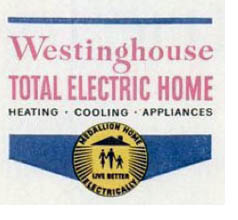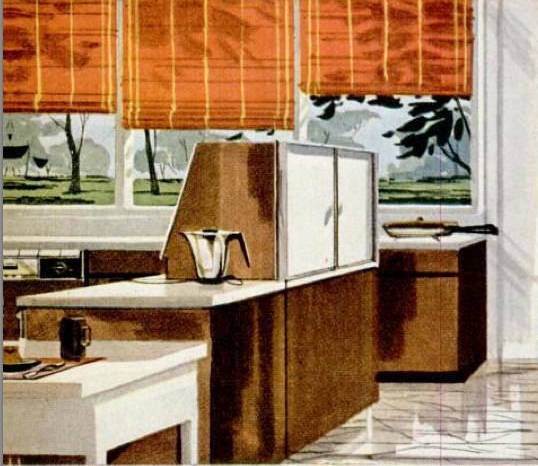|

I grew up in a push-button kitchen. I’ve no idea whether the burners actually had four different levels of heat, but all those buttons made the stove look like something from a spaceship, and the electric oven with its dials and clunky switches accentuated the reminder that I was living in the modern world. Everything before was old and dumb. Everything in the future would be done by pushing a button.
The image at the top of the page: Total Electric Living. We’ll get into this below the fold in Odds & Ends.
----
Remember what I said about snow yesterday: This morning wasn't as bad as I thought it would be.



It's wrong. Late dump on the leaves; not a quarter of the trees are bare. Winter doesn't care. Winter is hungry. It's always hungry. When the storms come it seems like it's starving, and it's never full.



Back to the Electrical House of Tomorrow, from a big 1959 Westinghouse ad. Dad’s pad was swank:



The hi-fi had a reel-to-reel deck; there was a big TV in the middle - I mean look at the size of that thing! - and one embedded in the wall for no reason you could imagine, unless . . . no, couldn’t be. They didn’t have closed-circuit TV for communication around the house. That would be too cool.
The Fridge of Tomorrow, Tod - well, Tomorrow:





Not yet on the market, but such promise! So much promise that it never made it to the market. Looks like a terminal for a Mark-III mainframe terminal - now in this season’s stylish hues.
If you’re wondering about the item on the wall in the right rear:



That’s right, it’s a Weather CONTROL panel. It de-ices the sidewalks, which have heating coils embedded, and turns on the sprinkler. Half a century later, I have half of that. It also controls the Preiciptron units, which filter the air. Precipitron? Yes:


Laundry:



Closed-circuit TV so you could watch the kids. Micarta was a Westinghouse-designed (really, George Himself came up with it) composite substance that . . . oh, just read wikipedia. Just in case this electrical utopia makes you think of a world so unlike ours, so free of care:
Micarta 259-2 was used as the ablation heat shield material in early ICBM warheads.
Yes, there's that. Now, the heart of it all: the kitchen. The picture has to be cut up, alas:





It's not as high tech as you'd expect, but it's the wall inserts that do it. They loved those. I love those. Control panels! Automatic recipe readers! I suspet the device on the far left is a microfiche recipe reader; such devices were used in the 1969 Florida project in Coral Springs. Westinghouse built "Electra-Lab"
homes in a special subdivision. They still exist. Sort of. The Sun-Sentinal wrote:
When William and Donna Teat first saw the house on the 9200 block of Northwest 14th Court in 1988, the real estate agent didn`t even want to show the home. The previous owners had been arrested on drug charges and the place had been in bank receivership for years. Renters had allowed the gold shag carpets to become threadbare and the wallpaper to peel from the walls.
"We were able to look beyond the cosmetic things,`` Donna Teat said. ``We could see the possibilities."
Although they enjoy their home`s energy-saving features, the Teats laugh at some of the other appliances from the past. They disconnected a bedroom light that turned on whenever someone walked through the door, because the dog kept turning it on. They still enjoy the motorized bed that spares backbending when they change the sheets.
A device in the kitchen is set up to read recipes on microfilm. But Betty Crocker was the only one to offer recipes in that medium. "The projector`s bulb burned out,`` William Teat, an electrical engineer, said. ``Replacing it hasn`t been a priority."
That was 1991. I imagine nothing's left today.
I wrote most of the above this afternoon while sleepy, with a note at the end: “say what this means.”
I know what I meant by that, and it’s rather touching to think that I do know what it means; in the case of the Electrical Home of Tomorrow, it’s entirely a case of projection, retrospective rewriting of vague trends I’ve gleaned from a few decades as an amateur commercial archeologist. To use the pretentious term. You can study Actual History, how things played out in the hard world; you can study the Myths and Aspirations of Advertising, which is the story about how things are supposed to play out, and should play out, and gosh darn it ought to play out - why shouldn’t this detergent make you smile? Maybe not as much as the gal in the ad, but the whites are whiter and the colors are brighter, and if you can’t take the time to smile about it just once it’s because you're inured to the ceaseless promise of progress, and the appearance of the whiter-white future reminds you A) you’ve been promised whiter-whites for some time, and B) you’d factored in the whiter-white future in your calculations of the way life should be, so the appearance of the real thing is nothing new, just the present catching up with yesterday’s description of tomorrow.
I shouldn’t use detergent ads as an example of the the Myths and Aspirations, because they’re generally ridiculous. Women are practically manic over the power of new Blueing Crystals with Bleaching Power, staring out from the paintings with expressions of vacuous rapture. They changed in the 50s, when the great sea-change of advertising began to dethrone illustration in favor of spare, staged, sophisticated photography. Now the Mom looked with amusement at the little daughter as they pulled the sheets out of the wash. The two of them at home on a chore day, mother’s little helper, a rote duty transformed into a moment that meant something different for each one. Daughter was being useful to Mommy and Mommy was enjoying the time they had together. The particular detergent, and its claims, were irrelevant. It wasn’t a detergent at all, it was domestic cement.
The difference between the two styles? Everyone knew the first was an exaggeration, a Myth, but the second was an Aspiration. And a reasonable one, too. Below you’ll see Dad’s Swank Media Room, and all that’s missing is the man standing at the window with a glass of something brown, considering the pleasures of this particular moment, the satisfactions of consumption. Which, we are told, is the problem. But it’s just a different version of a standard human emotion, when things combine to provide well-being and satisfaction for the moment.
The All-Electric House of Tomorrow does not bring happiness, but there’s nothing wrong with being happy in the All-Electric House of Tomorrow.
Before I started to study this stuff I came across a song that hit me where I lived, made me think about growing up in the last emanations of the Age of Optimism that lived right alongside the cynics and critics.


What a beautiful world this will be / What a glorious time to be free You hear the line first as the sarcasm of the jaded modern, then as the certainty of the previous era, and finally in the voice of a parent reading “happily ever after” to a child heading off to sleep.
|

